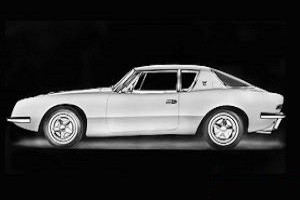Conceived as an image-booster for the ailing Studebaker company, the fiberglass Avanti was a striking GT car. Studebaker president Sherwood Egbert first conceived such a sporting flagship but it was styled by Raymond Loewy, the legendary American industrial design genius most closely identified with the curvaceous Coca-Cola bottle.

Studebaker Avanti 1962
- YEAR REVEALED 1962
- PLACE OF ORIGIN South Bend, Indiana
- HISTORICAL STATUS production car
- ENGINE V8-cylinder, 289ci (4,736cc)
- MAXIMUM POWER 335bhp
- LAYOUT front-mounted engine driving the rear wheels
- BODYWORK two-door four-seater coupé
- TOP SPEED 145mph (233kph)
- NUMBER BUILT 4,643
The Avanti’s unadorned and rakish lines were in sharp contrast to Detroit’s normal, overblown, chrome-plated excess. The interior was modeled on a typical Italian sports car, with clear instruments and leather-clad bucket seats. Showered with acclaim, the Avanti was destined for a short life luring buyers into Studebaker showrooms, because the company’s bankrupt US car division shut down in 1964.
While some production transferred to Canada, the Avanti was axed. However, local Studebaker dealers Nate Altman and Leo Newman bought the rights to the car and vowed to continue making it. The Studebaker engine was obsolete, so they bought in Chevrolet Corvette units. Each Avanti II was now painstakingly hand-built.
The Avanti Motor Corporation became an institution, and survived profitably until 1982, when the families of Altman and Newman-both now dead-sold up. Subsequently, several entrepreneurs have hatched grand plans, revealed new models, and eventually transferred the car’s production south to Mexico where, in theory, new Avantis are still available.